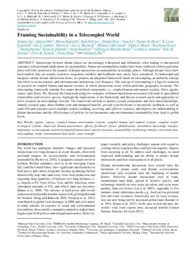Framing sustainability in a telecoupled world.
Framing sustainability in a telecoupled world.
Author(s): LIU, J.; HULL, V.; BATISTELLA, M.; DEFRIES, R.; DIETZ, T.; FU, F.; HERTEL, T. W.; IZAURRALDE, R. C.; LAMBIN, E. F.; LI, S.; MARTINELLI, L. A.; MCCONNELL, W. J.; MORAN, E. F.; NAYLOR, R.; OUYANG, Z.; POLENSKE, K. R.; REENBERG, A.; ROCHA, G. DE M.; SIMMONS, C. S.; VERBURG, P. H.; VITOUSEK, P. M.; ZHANG, F.; ZHU, C.
Summary: Interactions between distant places are increasingly widespread and influential, often leading to unexpected outcomes with profound implications for sustainability. Numerous sustainability studies have been conducted within a particular place with little attention to the impacts of distant interactions on sustainability in multiple places. although distant forces have been studied, they are usually treated as exogenous variables and feedbacks have rarely been considered. To understand and integrate various distant interactions better, we propose an integrated framework based on telecoupling, an umbrella concept that refers to socioeconomic and environmental interactions over distances. The concept of telecoupling is a logical extension of research on coupled human and natural systems, in which interactions occur within particular geographic locations. The telecoupling framework contains five major interrelated components, i.e., coupled human and natural systems, flows, agents, causes, and effects. We illustrate the framework using two examples of distant interactions associated with trade of agricultural commodities and invasive species, highlight the implications of the framework, and discuss research needs and approaches to move research on telecouplings forward. The framework can help to analyze system components and their interrelationships, identify research gaps, detect hidden costs and untapped benefits, provide a useful means to incorporate feedbacks as well as trade-offs and synergies across multiple systems (sending, receiving, and spillover systems), and improve the understanding of distant interactions and the effectiveness of policies for socioeconomic and environmental sustainability from local to global levels.
Publication year: 2013
Types of publication: Journal article
Unit: Embrapa Territorial
Keywords: Agents, Causes, Coupled human and natural systems, Coupled human-environment systems, Coupled socialecological systems, Dispersal, Distant interactions, Effects, Feedbacks, Flows, Globalization, Investment, Knowledge transfer, Migration, Socioeconomic and environmental interactions, Species invasion, Sustainability, Technology transfer, Teleconnection, Telecoupling, Trade, Transnational land deals, Water transfer
Observation
Some of Embrapa's publications are published as ePub files. To read them, use or download one of the following free software options to your computer or mobile device. Android: Google Play Books; IOS: iBooks; Windows and Linux: Calibre.
Access other publications
Access the Agricultural Research Database (BDPA) to consult Embrapa's full library collection and records.
Visit Embrapa Bookstore to purchase books and other publications sold by Embrapa.

